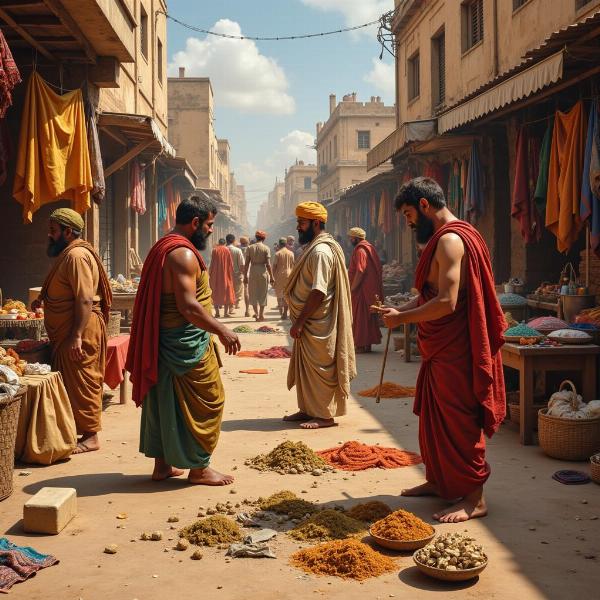Cubits meaning in Hindi often sparks curiosity, especially when encountering ancient texts or historical accounts. Understanding this unit of measurement provides valuable insights into India’s rich past and cultural heritage. This article delves into the various aspects of “cubits” in Hindi, exploring its historical significance, practical applications, and cultural connections.
Decoding the Cubit: Historical Context and Hindi Equivalents
Historically, a cubit represented the length of the forearm from the elbow to the tip of the middle finger. This naturally led to variations across regions and time periods, as individual forearm lengths differ. In Hindi, the cubit is commonly referred to as “हस्त” (hasta), directly translating to “hand.” Other terms like “कोहनी” (kohni – elbow) or “बालिश्त” (baalisht) might also be used, depending on the specific context. Understanding these variations is crucial for accurate interpretation.
Practical Applications of Cubits in Ancient India
Cubits were fundamental in various aspects of ancient Indian life, from architecture and construction to trade and textile production. Imagine the construction of grand temples and palaces, where measurements were based on this readily available human unit. Similarly, merchants used cubits to measure fabrics and other goods, facilitating trade and commerce. This widespread use demonstrates the practicality and accessibility of the cubits in a time before standardized measurement systems.
Cubits in Architecture and Construction
The use of cubits in architecture is evident in the precise dimensions of ancient structures. Many historical texts and inscriptions detail measurements in cubits, providing valuable insights into the construction techniques of the past. This practice highlights the importance of the cubit as a standardized unit within specific communities and projects.
Cubits in Trade and Commerce
In the bustling marketplaces of ancient India, the cubit served as a handy tool for measuring fabrics, ropes, and other commodities. This facilitated fair trade and ensured consistent measurements across different vendors and regions.
 Cubit Use in Trade in Ancient India
Cubit Use in Trade in Ancient India
Cubits in Religious and Cultural Contexts
Beyond its practical applications, the cubit also held symbolic and religious significance. In Hindu mythology and iconography, deities are often depicted with specific measurements, often expressed in cubits. This adds another layer of meaning to the unit of measurement, connecting it to the divine and the cosmos.
Cubits in Hindu Mythology
The use of cubits to describe the physical attributes of deities highlights the importance of proportion and harmony in Hindu cosmology. This practice adds a symbolic dimension to the cubit, connecting it to the divine and the sacred.
From Cubits to Modern Measurements: Understanding the Transition
The transition from cubits to modern standardized units of measurement was a gradual process, driven by the need for greater precision and consistency across larger geographical areas. While the cubit served its purpose in ancient times, the advent of standardized units like meters and feet allowed for more accurate and universally accepted measurements.
Conclusion: The Enduring Legacy of the Cubit
While the cubit is no longer a standard unit of measurement, its historical significance remains undeniable. Understanding “cubits meaning in Hindi” allows us to appreciate the ingenuity and practicality of ancient Indian civilization. It offers a glimpse into a time when the human body served as a readily available measuring tool, shaping architecture, trade, and even cultural beliefs.
FAQ
- What is the exact length of a cubit? The length of a cubit varied historically, as it was based on the individual’s forearm. It generally ranged from 44 to 53 centimeters.
- Is “hasta” the only Hindi word for cubit? While “hasta” is common, other terms like “kohni” and “baalisht” might also be used.
- Why did people stop using cubits? The need for more standardized and precise measurements led to the adoption of modern units like meters and feet.
- Are cubits still used anywhere today? While not used for official measurements, cubits might still be referenced in historical or cultural contexts.
- Where can I find more information about ancient Indian measurement systems? Historical texts, archaeological studies, and museums are excellent resources for learning more.
Connect with Meaning-Hindi.in for Expert Language Solutions
Meaning-Hindi.in is your trusted partner for all your Hindi language needs. We offer a comprehensive range of professional translation services, including business and commercial document translation, certified and legal document translation, technical and user manual translation, website and localization services, and educational and academic translation. We also specialize in expedited translation services for urgent projects and offer expertise in various specialized fields. Need accurate and culturally sensitive Hindi translations? Contact us today at [email protected] or call us at +91 11-4502-7584. Meaning-Hindi.in – bridging language barriers and connecting cultures.